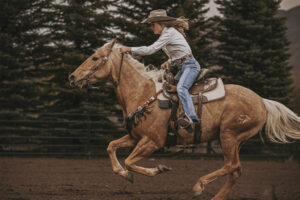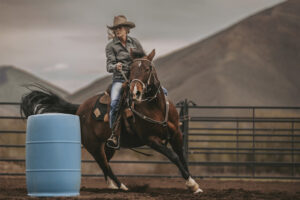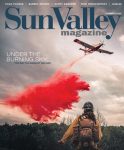The horse explodes into the arena at top speed, kicking up dirt as it races toward the first of three barrels placed in a triangular pattern in the center of the arena. As it blasts toward the first barrel, the rider needs to know when to slow down just enough to make a tight, hairpin circle around the barrel without knocking it down. The team then gears up to a full gallop to perform the same gutsy moves around the next two barrels. After the final turn, they race against the clock toward the exit. The entire run is over in mere seconds.
This is women’s barrel racing, an adrenaline-fueled sport known for its speed, precision, athleticism, and a trusting partnership between horse and rider. It’s a sport often won by margins of hundredths of seconds. There is no time for wrong moves or mistakes when you’re up against the clock and risking injury at every turn.
Evolution of Women’s Barrel Racing
Barrel racing originated in the early 1900s as a way for women to participate in male-dominated rodeos. At that time, women’s barrel races were exhibition events judged for elegance and graceful movement of their horses and their own attire, rather than speed or performance.
In 1948, 38 ranch women met in Texas to form an all-female rodeo sanctioning body, the Girls Rodeo Association (GRA), renamed Women’s Professional Rodeo Association (WPRA) in 1981. The WPRA has played a crucial role in setting standardized rules for barrel racing, including the official cloverleaf pattern, which emphasizes speed and control. Through the years, female barrel racers have revolutionized the rodeo world, proving over and over that they are among the most talented and fearless athletes in professional sports.
Cynthia and Kate
Bellevue barrel racer Cynthia Carroll began her lifelong love affair with horses, spending summers at her father’s ranch in California, where she learned to ride, rope, and compete in rodeo, a passion she continued through school into adulthood.
When she moved to Idaho, Carroll began competing in the Hailey Rodeo. One day in 2020, as she was practicing roping at a friend’s house, she hopped on a mare there, and lost her heart to her soon-to-be new team roping head horse, Kate Shining Mirada, or Kate.
“I sent her to a barrel trainer, Brandon Labbee of 7B Performance Horses in Buhl during the winter of 2020-2021, and we started competing together that spring,” she said. “She’s an incredibly consistent horse, and if I do my part, she gives me the same run every time.
Carroll, Kate, and her other horse, GQ, compete two or three times a week in various Jackpots throughout Idaho and northern Utah. Jackpots are generally barrel racing-only events.
“Barrel racing saved my life”
Carroll has had her share of wrecks, but there is one that she said was her life-saver.
“It happened at the Southern Idaho Barrel Racing Association’s (SIBRA) year-end finals in September 2023 on my horse, GQ. He ducked into the third barrel, and I pitched forward pretty violently and cracked my rib on the horn.”
She ended up in the emergency room. Doctors were worried about an internal bleed and ordered a CT scan. The result was that they found clear cell renal carcinoma in her left kidney, Stage 3. She had no symptoms.
“If I hadn’t broken my ribs on GQ, we never would have found the cancer. Barrel racing literally saved my life.”
She also had to have a full hip replacement and took 18 months off to recover, but is now back competing, having run eight races already in 2025. Her fastest time recorded on a standard pattern is 17.1 seconds.
“The relationship between rider and horse is the most important aspect of barrel racing. I mean, you’re a team, and you have to trust your horse. You’re going fast and turning hard, so you have to trust them.
“I love how different each horse is. Kate is a bit of a nervous princess with a huge side of bad ass, and she saves me a lot when I make a mistake. GQ doesn’t let me get away with anything; he’s a bit of a freight train, and we hit a lot of barrels, but the feeling when we get a good run in is incredible. The horse I just sold, Dice, loves a crowd, and I swear he thinks the fireworks at the Hailey rodeo are all for him, so he runs his heart out. At a jackpot, he sometimes runs hard and sometimes just phones it in, but he decides when he’s gonna go for it.
“But, when it all goes well, it really is the most exhilarating feeling in the world. I think it’s as close to flying as we humans are going to get.”
Addee and Barbie
Addee Hall has been riding since she was a little girl. Now, 16 years old, the Ketchum sophomore is heading into her second year of barrel racing competition.

Horses and riders from left to right: Malibu Barbie, Addee Hall, Kate, Cynthia Carroll, and G.Q. Photo by Ryann Deaville.
Heading into high school, Hall was already competing in hockey, and she started thinking about adding another sport – barrel racing.
Although her parents were not horse people, they were completely supportive and began asking around about available barrel horses. Soon, Bellevue barrel racer Cynthia Carroll reached out to her.
“I had never met or talked with Cynthia before, but she was like, ‘Why don’t you come over to my house and ride some horses, and I can evaluate you and see what you can handle,’ said Hall.
After that meeting, Carroll put the word out for Hall. “I think I found my horse two months after that.”
Her name is Malibu Barbie.
“My horse was fully patterned and she just wanted to go, go, go,” Hall said. “I was still learning and wanted to take things slow, and it took me a long time to trust her and trust that I knew what I was doing.” At Carroll’s suggestion, she got barrel training in Buhl, which put her horse where she could feel the most confident to perform.
Hall competes primarily in southern Idaho through SIBRA, the Southern Idaho Barrel Racing Association, which hosts most of the events in the area.
She said one of the hardest parts of racing is to be in sync with your horse. “You can be as ready as you can, but your horse may not always be on the same page. You need to be super in tune with your horse, like ‘this is your job, this is my job,’ and put your horse in the best spot possible so they can do their job.”
She’s made about 70 runs; her fastest time around the barrels is 19.0 seconds.
Her advice for young riders wanting to get involved in the sport?
“Make connections because it’s helpful when you know people who are looking out for you. And, make sure you’re having fun. The racing community is super supportive, and they’re always there if you ever need anything.”

Addee Hall rides fast with Malibu Barbie. Photo by Ryann Deaville.
Lana Parker, founder of SIBRA
Lana Parker has a long and colorful history in barrel racing. She got her first barrel horse as a gift from her older sister and rode in high school and college. She was Miss Rodeo Idaho and the 1971 Miss Rodeo America, an annual pageant that selects the official spokesperson for the Professional Rodeo Cowboys Association.
She and her husband, Tim, have lived in Wendell for 43 years on 10 acres. “When I got married, I kept riding barrels, and then my daughter Kali came along, and she was a natural. When she was nine, I started putting her on some of my better horses. I was her mentor, and soon she was outdoing me and became my mentor,” Parker said.
Someone once asked Parker why she quit running barrels. “Well, it’s pretty hard when your nine-year-old girl beats you all the time,” she laughed.
When Kali used to compete, she was among the top 25 racers in the world. Today, she trains futurity colts and barrel horses on the Parkers’ ranch. Currently, she is working with about 16 heads.
SIBRA
In 1986, Parker and her husband formed the Southern Idaho Junior Rodeo Association (SIJRA), in which young rodeo athletes had the opportunity to compete and be exposed to the rules and processes of professional rodeo.
“Many National High School, Collegiate, and PRCA champions came through SIJRA, including Zane Davis, Cody DeMers, TW Parker, Kali Parker, Kini Wright, to name a few,” said Parker.
In 2005, Parker revamped the junior association into the Southern Idaho Barrel Racing Association, or SIBRA. The group produces professional barrel racing events at venues that provide good ground and safe facilities, and where riders and horses at every level can compete for prize money and awards.
“We try to give the barrel racing community the opportunity to compete and grow, and we are backed by some very giving sponsors, allowing us to offer bigger and better events, support the CSI Rodeo Team, and bring great opportunities to the Magic Valley such as the KK Run For Vegas.”
From the inception of the junior program, through the past 20 years of SIBRA, Parker said they have endeavored to live up to their motto and goals, “Making today’s contestant tomorrow’s champion!”

Cynthia Carrol and Kate round a barrel during practice. Photo by Ryann Deaville.
What is a standard barrel racing pattern?
A standard barrel racing pattern, as defined by the Women’s Professional Rodeo Association, has the following dimensions:
- 60 feet from the starting line, called the scoreline, to the 1st or2nd barrels
- maximum of 90 feet between barrels 1 and 2
- maximum of 105 feet between barrels 1 and 3, and between barrels 2 and 3
- minimum of 60 feet from timers to barrels 1 and 2
- Penalties: 5-second penalty for knocking over a barrel
- Barrel racing is run in a pattern that’s shaped like a cloverleaf. Horses start the pattern by running for the right barrel first and must end on the furthest barrel. The horse will do a figure eight around the first two barrels, then loop around the last before running back toward the gate.
What are Futurity and Derby/ Maturity races?
- Futurities are generally for young horses, typically four and five years old in their first year of competition. They cannot have competed in any barrel racing events for money, prizes, or points before a specific date.
- Derby races are for horses that are typically five, six, and seven years old. They may have competed in futurities or other barrel racing events.
- Maturity classes are generally open to horses older than the typical derby age, often eight years old and under, but the specific age range can vary depending on the event. Mature horses are experienced competitors that have typically run in futurities, derbies, and open barrel races.
What is a Jackpot?
Jackpot barrel races are informal or local barrel racing competitions where riders pay an entry fee to compete, and the prize money (the “jackpot”) is made up of the pooled entry fees. They’re a popular format in the rodeo and barrel racing world because they’re often more accessible and relaxed compared to big, sanctioned events like those put on by the WPRA.
Here’s how they work:
- Entry Fee: Each rider pays to enter.
- Payout: The total pot (jackpot) is divided among the top finishers, usually based on time.
- Divisions (D System): Often, they use a “D” system (1D, 2D, 3D, etc.), which splits the competition based on time differences from the fastest run. That way, more riders can win something, even if they’re not the fastest overall.
So, even if you’re not a pro-level rider, you can still place and receive winnings in the lower levels.
Rodeo Dress Code
The WPRA Rule Book states:
Contestants’ appearance must be neat, clean, and professional. Any contestant whose appearance is deemed unprofessional will be fined. The fine will be $100.00. Contestants must wear collared long-sleeve shirts with either buttons, snaps, or a full-length zipper on the front of the shirt. Jeans without holes, western boots and a Western hat must be worn for all rodeo. Helmets are acceptable for any WPRA competition. (Source: WPRA 2025 rule book)
Rodeo Associations
- WPRA – Women’s Professional Rodeo Association
- PRCA – Professional Rodeo Cowboys Association is the world’s oldest and largest professional rodeo-sanctioning body. In 2023, the PRCA sanctioned 790 events in 37 states and three Canadian provinces. The National Finals Rodeo is the PRCA’s premier event.
- NBHA – National Barrel Horse Association is the largest barrel racing organization in the world.
- (NHSRA)The National High School Rodeo Association is an international organization dedicated to promoting rodeo among high school students.


